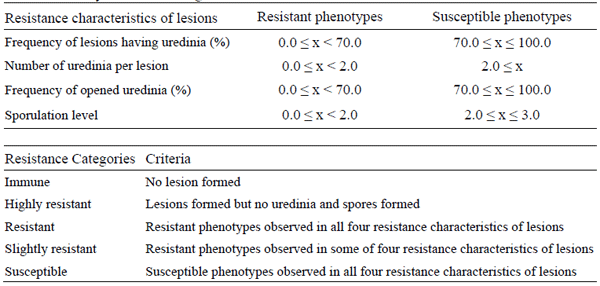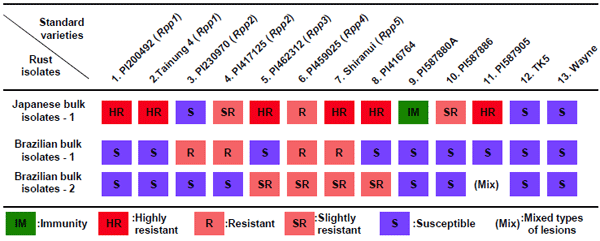Reaction differences of soybean varieties against Brazilian and Japanese soybean rust isolates
Description
South America, including Brazil, is one of the major soybean producers in the world. Thus, sustainable soybean production in South America is very important for Japan where more than 90% of soybean consumption is dependent on import. In the last several years, however, soybean rust has become one of the most serious threats to soybean production in Brazil by causing yield reduction of about 600 million US dollars in the 2006/2007 cropping season. On the other hand, many resistant varieties have already been identified or developed in Asia where this disease has been observed since ancient times. Information about virulence is necessary in order to know the usefulness of known resistant varieties/genes.
Three kinds of rust isolates used for inoculation were “bulk isolates”, mixtures of spores obtained from multiple soybean leaflets infected with soybean rust. One isolate was collected at Kannondai, Tsukuba City, Ibaraki, Japan in September 2007 and the other two were respectively collected in January and August, 2008 at the National Soybean Research Center of EMBRAPA, Londrina City, Paraná, Brazil. All three isolates showed typical symptoms of soybean rust; i.e. brown lesions are formed mainly on the leaves of susceptible soybeans, spores are produced, and yellowing and falling of leaves occur thereafter. The original classification criterion of resistance against soybean rust (Table 1) is based on four characteristics related to resistance: frequency of lesions having uredinia, number of uredinia per lesion, frequency of opened uredinia, and sporulation level (Fig. 1). Because this classification criterion of resistance is based on a test using 63 varieties, it can also be used for determining the resistance of other soybean varieties.
A total of 13 Asian soybean varieties, including the varieties which possess one of five known resistance genes, were tested for resistance reaction against three kinds of isolates. Brazilian isolates showed higher virulence than Japanese one and the reaction differences between the Japanese and Brazilian isolates observed in these varieties were quite large, i.e. All varieties, except for one variety having Rpp2 and two susceptible standard varieties, were found resistant against Japanese isolates. However, only four varieties were resistant against the two Brazilian isolates, respectively (Table 2). In addition, the resistant varieties and the degree of their resistance were different between the two Brazilian isolates.
We need to utilize multiple resistance genes for the breeding of resistance varieties. However, resistance genes and varieties used for soybean breeding in Brazil are limited. In addition, the resistance of varieties/lines being screened for breeding materials should be confirmed by rust isolates collected from a wide area of Brazil in order to take into consideration the yearly and regional differences in Brazil.
Figure, table
-
Fig. 1. Standard for sporulation level of lesions of soybean rust. -
Table 1. Classification of phenotypic traits associated with resistance and criteria to determine resistance of soybean varieties against rust.
Each value is obtained from 30 lesions. -
Table 2. Phenotypes of resistance against Japanese and Brazilian rust isolates in 13 standard varieties.
1-7: Varieties having one of known resistance genes (Names of genes in parentheses), 8-11: Varieties with identified resistance but yet unidentified genes, 12 and 13: Susceptible standard varieties.
- Affiliation
-
Japan International Research Center for Agricultural Sciences Biological Resources Division
- Classification
-
Technical A
- Term of research
-
FY2008(FY2007~2008)
- Responsible researcher
-
YAMANAKA Naoki ( Biological Resources Division )
- ほか
- Publication, etc.
-
Yamanaka, N., Yamaoka, Y., Kato, M., Mori, T., Kudo, H., Passianotto, A.L. de L., Santos, J.V.M. dos, Benitez, E.R., Abdelnoor, R.V., Soares, R.M. and Suenaga, K. (2008) Differences between Japanese and Brazilian isolates of Asian soybean rust in the pathogenicity to resistant varieties and resistance genes. 41°Congresso Brasileiro de Fitopatologia, MEL-004.
- Japanese PDF
-
2008_seikajouhou_A4_ja_Part9.pdf508.41 KB



